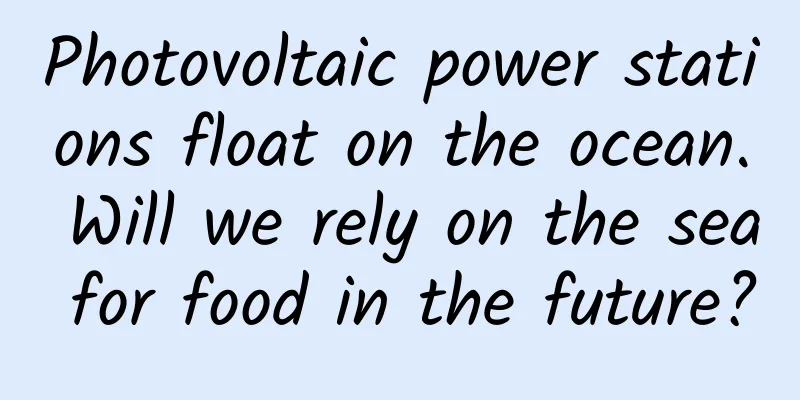Photovoltaic power stations float on the ocean. Will we rely on the sea for food in the future?

|
Can solar panels only be laid on land? No! They can also be laid on the sea. Recently, my country's largest offshore photovoltaic project, the China National Nuclear Corporation Tianwan 2 million kilowatt beach photovoltaic demonstration project, officially started construction in Lianyungang, Jiangsu. After the project is fully completed, it will be coupled with the China National Nuclear Corporation Tianwan Nuclear Power Base to form a large-scale clean energy base with a total installed capacity of more than 10 million kilowatts, which can reduce carbon emissions by 1.77 million tons per year. This is incredible. Just think about how big the ocean is. If we follow this idea and lay more solar panels on the sea surface, the energy problem can be greatly alleviated. So you see, as I mentioned above, this project is just a "demonstration project", that is, this is currently the largest offshore photovoltaic power station in my country, it is just a model. After the proofing is completed, the follow-up is to spread out and replicate. There is still a lot of room for imagination in offshore photovoltaics. Well, what are the specific advantages of laying photovoltaic power stations on the sea? What challenges will we encounter? How can we deal with them? Let's briefly discuss them below. Let's talk about the advantages of offshore photovoltaics first. In summary, there are four main advantages: First, offshore photovoltaic power stations can greatly save land resources on land, which is one of its most significant advantages. At present, land resources are tight in many countries and regions, especially in cities and industrially developed areas. The construction of large-scale photovoltaic power stations often faces the problem of land scarcity. Moving photovoltaic power stations to the sea can not only avoid competing for land with agriculture, urban construction and other fields, but also free up more space for other important uses on land. For example, agricultural land can continue to be used for food production, and urban land can be used to develop residential and commercial facilities, thereby achieving the optimal use of land resources. Second, offshore photovoltaic power stations can effectively avoid land use conflicts. The construction of land-based photovoltaic power stations often requires the installation of photovoltaic panels on large tracts of land, which may cause conflicts with industries such as agriculture, animal husbandry, and forestry, and may even lead to damage to the ecosystem. Offshore photovoltaic power stations do not involve these problems at all. They float on the sea, do not occupy any land, and do not affect the original use of the land. Therefore, offshore photovoltaic power stations can provide a large amount of clean energy without destroying the existing ecology and economic activities, truly achieving green development and sustainable development. Third, the unique environmental conditions of offshore photovoltaic power stations help improve the power generation efficiency of photovoltaic panels. First, the high reflectivity of the ocean surface can increase the amount of sunlight received by photovoltaic panels, thereby improving power generation efficiency. Second, the ocean environment temperature is relatively stable, and the water surface can provide a natural cooling effect for photovoltaic panels, avoiding the negative impact of high temperature on the performance of photovoltaic panels. High temperature will reduce the photoelectric conversion efficiency of photovoltaic panels, while at sea, photovoltaic panels are affected by the cooling effect of sea breeze and water bodies, and the temperature is relatively low, thereby maintaining a high power generation efficiency. In addition, the air at sea is relatively fresh, with less dust and pollutants, and the surface of photovoltaic panels is cleaner, which can absorb solar energy more effectively. Fourth, offshore photovoltaic power stations are significantly environmentally friendly. Compared with land-based photovoltaic power stations, offshore photovoltaic power stations have less impact on the ecological environment. They will not occupy land ecologically sensitive areas, such as important ecosystems such as forests, wetlands and grasslands, and can effectively avoid damage to animal and plant habitats. In addition, through reasonable layout and scientific design, offshore photovoltaic power stations can minimize the impact on marine life and ecosystems. Some designs even take into account the living environment of marine life, using environmentally friendly materials and structures, so that photovoltaic power stations can coexist harmoniously with the surrounding ecological environment, truly realizing the harmonious development of man and nature. From the above advantages, we can see that offshore photovoltaic power stations are really one of the important directions for the development of clean energy in the future, because they provide new solutions for global energy transformation and ecological protection. However, this solution also faces many challenges. There are many benefits at sea, but there are also many disadvantages at sea. They are: In the marine environment, the high concentration of salt is one of the primary challenges facing photovoltaic power stations. Salt in seawater and sea breeze forms salt mist, which adheres to the surface of photovoltaic equipment and causes serious corrosion problems. When metal parts such as brackets, junction boxes and cables are exposed to salt mist for a long time, oxidation reactions will occur, resulting in reduced material strength, structural damage, and even electrical short circuits. This corrosion will not only shorten the service life of the equipment, but also increase maintenance and replacement costs. According to research, the impact of salt mist on electronic components is particularly significant, which may cause poor contact and reduced electrical performance. Secondly, the high humidity in the offshore environment also poses a considerable challenge to the operation of photovoltaic power stations. High humidity makes it easy for water vapor in the air to condense into water droplets inside the equipment and electrical connections, forming condensation. This condensation will cause the electrical insulation performance to deteriorate and increase the risk of leakage and short circuit. In addition, long-term humid environment will also cause the packaging materials in photovoltaic modules to age and peel off, affecting the photovoltaic conversion efficiency and overall reliability of photovoltaic panels. Especially in an environment with a large temperature difference, the condensation and evaporation cycle caused by the temperature difference between day and night aggravates the aging and damage of equipment. At the same time, although the sea surface temperature is relatively stable compared to land, offshore photovoltaic power stations will still face the challenge of high temperature under strong sunshine conditions. The electrical performance of photovoltaic modules will be significantly reduced in high temperature environments, mainly manifested in reduced output power and reduced efficiency. According to the temperature coefficient of photovoltaic modules, the efficiency of photovoltaic modules will decrease by 0.4% to 0.5% for every 1 degree Celsius increase in temperature. In addition, high temperature will accelerate the aging of photovoltaic materials, such as thermal oxidation degradation of backplane materials and thermal failure of packaging materials, resulting in a shortened service life of the equipment. This poses a severe test to the long-term operation and economy of offshore photovoltaic power stations. In addition to the above factors, the dynamic characteristics of the marine environment are also one of the challenges that photovoltaic power plants must deal with. Changes in sea surface wind and waves will cause the mechanical structure of photovoltaic equipment to bear additional dynamic loads. Especially in stormy and high-wave weather, photovoltaic panels and brackets need to have sufficient strength and toughness to withstand the impact and swing of wind and waves. In addition, the rising and falling tides of the sea will affect the stability of the floating system of the photovoltaic power plant. Therefore, in order to meet the above challenges, we have to work hard in material selection and research and development, structural design, system design and protection design. When facing the corrosion problem of the high-salt marine environment, we need to use some special corrosion-resistant materials and strengthen the protection of anti-corrosion coatings and anodized materials; when facing the waterproof and moisture-proof problems in high-humidity environments, we need to do enough homework in the following aspects: sealing, moisture-proof and dehumidification. High-efficiency sealing materials such as silicone sealing rings and butyl rubber are used in key parts such as photovoltaic modules and electrical junction boxes to prevent water vapor from entering the interior of the equipment. Especially in cable joints and connection parts, it is necessary to ensure complete sealing to avoid condensation and short circuits. The photovoltaic modules are packaged in moisture-proof packaging with high-quality packaging materials, such as ethylene-vinyl acetate copolymer (EVA) and polyvinylidene fluoride (PVDF), which have excellent moisture-proof properties and can effectively block moisture. Dehumidification devices, such as heaters or dehumidifiers, are installed in electrical cabinets and control rooms to keep the internal environment dry and prevent condensation. Next, when facing high temperature environments, we need to design a more efficient cooling system in combination with better thermal management materials, using air cooling and water cooling to transfer heat from the inside of the equipment to the external environment to improve heat dissipation efficiency. In order to cope with the challenges of the dynamic marine environment, offshore photovoltaic power stations must have a high degree of mechanical stability and adaptability. The following structural systems are the key to solving this problem: The floating system can evenly distribute buoyancy and stability, and improve the ability to resist wind and waves. At the same time, the floating platform needs to have a certain degree of flexibility to adapt to the ups and downs of the waves. Flexible anchoring systems, such as elastic anchor chains and adaptive anchoring technology, ensure that the photovoltaic power station remains stable under tidal changes and wind and wave impacts. The anchoring system needs to be optimized according to the geological conditions of the seabed to provide sufficient fixing force. Wind and wave resistant structures, such as increasing the rigidity of the bracket and using vibration reduction devices, ensure that the photovoltaic panels remain stable even in strong winds and high waves. In short, there are many challenges. But if you are an engineer, you must be very excited now. Challenges bring opportunities, and opportunities can create the future. The bigger the stage, the more room we can play! Speaking of playing space, the future of photovoltaic power generation is actually far more than just on the sea surface, it is also on roofs, walls, farmland and deserts, and even on tracks! Photovoltaic panels are installed above the farmland, and the height and spacing of the panels are adjusted to ensure that the crops can get enough light. At the same time, photovoltaic panels can reduce direct sunlight, lower surface temperature and evaporation, and help improve crop yields and quality. Photovoltaic panels are installed above the pasture to provide electricity for the pasture and provide shade and shelter for livestock. Photovoltaic panels can reduce grass evaporation, increase grass yield, and enhance the sustainability of the pasture. In the construction of desert photovoltaic power stations, ecological restoration technology can be combined to improve the desert environment and prevent further expansion of desertification through vegetation restoration and water resource management. This model can not only realize the use of renewable energy, but also promote ecological protection. These have been verified one by one. And space-based photovoltaic power stations, a concept that previously only existed in science fiction, are also becoming a reality. Large photovoltaic arrays are deployed in Earth orbit to generate electricity using high-intensity solar radiation in space. Without the obstruction of the atmosphere and the restriction of day and night, space photovoltaic power stations can receive solar energy 24 hours a day, and their power generation efficiency is much higher than that of ground photovoltaic systems. The electricity generated by the space photovoltaic power station is transmitted to the ground receiving station through microwaves or lasers, and then converted into electricity for human use. Breakthroughs in wireless energy transmission technology are the key to realizing space photovoltaics, and it is necessary to solve the problems of energy transmission efficiency and safety. And this key technology seems to be being solved. Last June, the Power Transfer Low Orbit Experiment Microwave Array (MAPLE), developed by Caltech, successfully demonstrated wireless power transfer of electricity from space to Earth. Using receivers on the ground, researchers received confirmation that MAPLE can successfully transfer power to space receivers installed on the ground. The signal appeared at the expected time and frequency, detected by a receiver located on the roof of the Gordon and Betty Moore Engineering Laboratory on the Caltech campus in Pasadena. After the receiver array received the energy, they converted it to direct current and lit up a pair of LEDs to demonstrate the complete sequence of wireless energy transfer over long distances in space. MAPLE completed this test in space by successfully lighting up each LED individually and switching back and forth between them. Therefore, we are getting closer and closer to being able to send solar power arrays into space, use sunlight for photovoltaic power generation in space, convert the electrical energy into microwaves, transmit them to the earth, and after the microwaves are received by receivers installed on the earth, they will be converted into electrical energy, thus realizing photovoltaic power generation and wireless power transmission in space - a rather sci-fi concept. Of course, a thousand miles are achieved by taking small steps. The future of photovoltaic power generation has infinite imagination. We still need to be down-to-earth and take every step well! This article is a work supported by the Science Popularization China Creation Cultivation Program Author: Gan Shudong, popular science creator Reviewer: Zuo Yuhua, Researcher, Institute of Semiconductors, Chinese Academy of Sciences Produced by: China Association for Science and Technology Department of Science Popularization Producer: China Science and Technology Press Co., Ltd., Beijing Zhongke Xinghe Culture Media Co., Ltd. |
<<: Summer heat is coming! Dig up the ancients' secret recipes for keeping cool
Recommend
What is the recommendation mechanism of Tik Tok short videos?
Tik Tok’s algorithm is extremely attractive. The ...
3 common scenarios for community operations!
First of all, we must make it clear that a commun...
How to implement community operation SOP?
The article shared today is a concise SOP from at...
Movie Hurricane reveals the dark side of video website bitstreams? Let's talk about some practical information
I believe that friends who have been browsing Bil...
"You can't live without being crazy!" How do weasels evolve the "soft power" that you can't imagine?
In this age when humans go crazy from time to tim...
Some details and thoughts on “Guess the Picture Song”
Quickdraw’s CNN-RNN model The quickdraw model use...
Without operational resources, how can a product be operated on its own?
If there are no operational resources, we can fin...
What is Happy Planet? Besides Earth, there is also... | Tutu Science Fiction
Q Could there be alien life on habitable planets?...
Have you received any orders from Baidu AiPurchasing? Is Baidu Ai Purchasing effective?
Since its launch, Baidu Ai Procurement products h...
Since dark matter is present throughout the universe, why can't humans perceive it, yet know it exists?
To clarify this issue, we need to first clarify t...
Metaverse NFT Industry Introductory Course (MPC)
Metaverse NFT Industry Introductory Course (MPC) ...
How to do cross-border marketing? One article explains
Hello everyone, today’s topic is very big - cross...
When information flow copywriting has been overused, how can you stand out and make users’ eyes light up?
Before we get into the topic, let’s look at a cas...
Is the agency fee for Bayinguoleng Chemical Mini Program high? Bayinguoleng Chemical Mini Program Agency Fees and Process
How much does it cost to be an agent for a chemic...
How to do content marketing without money? Can you do it?
"No money", "No budget"... ar...









